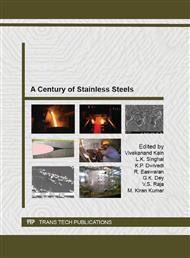[1]
J.C. Lippold, W.F. Savage, Solidification of austenitic stainless steel weldments, 1: a proposed mechanism, Welding Journal 58 (1979) 362s-374s.
Google Scholar
[2]
H.D. Solomon, T.M. Devine, Jr., Duplex stainless steels – a tale of two phases, Proc. Conf. Duplex Ferritic-Austenitic Stainless Steels, ASM Metals Congress, 1982, pp.693-756.
DOI: 10.1520/a1084-15
Google Scholar
[3]
F. Matsuda, H. Nakagawa, T. Uehara, S. Katayama, Y. Arata, A new explanation for the role of δ-ferrite in improving weld solidification crack susceptibility in austenitic stainless steel, Trans. JWRI, 8 (1979) 150-113.
Google Scholar
[4]
D.J. Kotecki, Welding of stainless steels, in: ASM Handbook, Vol. 6, Welding, Brazing and Soldering, tenth edition, ASM International, 1993, pp.677-707.
DOI: 10.31399/asm.hb.v06.a0001434
Google Scholar
[5]
V. Kujanpaa, N. Suutala, T. Takalo, T. Moisio, Correlation between solidification cracking and microstructure in austenitic stainless steel welds, Welding Research International 9 (1979), 55-75.
DOI: 10.1007/bf02697081
Google Scholar
[6]
V. Shankar, T.P.S. Gill, S.L. Mannan and S Sundaresan, Effect of nitrogen addition on microstructure and fusion zone cracking in type 316 stainless steel weld metals, Material Science and Engineering A 343 (2003), 170-181.
DOI: 10.1016/s0921-5093(02)00377-5
Google Scholar
[7]
J.C. Lippold, D.J. Kotecki, Welding Metallurgy and Weldability of Stainless Steels, John Wiley, New Jersey, (2005).
Google Scholar
[8]
J.A. Brooks, A.W. Thompson, Microstructural development and solidification cracking susceptibility of austenitic stainless steels welds, International Materials Reviews, 36 (1991) 16-44.
DOI: 10.1179/imr.1991.36.1.16
Google Scholar
[9]
J.C. Lippold, W.F. Savage, Solidification of austenitic stainless steel weldments, Part 3: The effect of solidification behaviour on hot cracking susceptibility, Welding Journal 61 (1982) 388s-396s.
Google Scholar
[10]
D.J. Kotecki, T.A. Siewert, WRC-1992 constitution diagram for stainless steel weld metals: A modification of WRC-1988 diagram, Welding Journal, 71(1992) 171s-178s.
Google Scholar
[11]
J. Honeycombe and T.G. Gooch, Effect of manganese on cracking and corrosion behavior of fully austenitic stainless steel weld metals, Metal Construction & British Welding Journal 4(1972) 456-460.
Google Scholar
[12]
Lundin, C.P.D. Chou, C.J. Sullivan, Hot cracking resistance of austenitic stainless steel weld metals, Welding Journal, 59 (1980) 226s-232s.
Google Scholar
[13]
J.C. Lippold, W.A. Baselack and I. Varol: Heat-affected zone liquation cracking in austenitic and duplex stainless steels, Welding Journal, 71 (1992) 1s-8s.
Google Scholar
[14]
Welding Handbook Vol. 4, eighth edition, American Welding Society, Miami (1998).
Google Scholar
[15]
E. Folkhard, Welding Metallurgy of Stainless Steels, Springer-Verlag, Vienna, (1988).
Google Scholar
[16]
T.G. Gooch, Corrosion behaviour of welded stainless steel, Welding Journal 75 (1996) 135s-154s.
Google Scholar
[17]
J.J. Smith, R.A. Farrar, Influence of microstructure and composition on mechanical properties of some AISI 300 series weld metals, International Materials Reviews 38 (1993) 25-51.
DOI: 10.1179/imr.1993.38.1.25
Google Scholar
[18]
S.W. Banovic, J.N. DuPont, A.R. Marder, Dilution and microsegregation in dissimilar metal welds between supeaustenitic stainless steel and nickel base alloys, Science and Technology of Welding and Joining, 7 (2002) 374-383.
DOI: 10.1179/136217102225006804
Google Scholar
[19]
F.B. Pickering, Physical metallurgy of stainless steel developments, International Metals Reviews 21 (1976) 227-268.
Google Scholar
[20]
K.F. Krysiak, J.F. Grubb, B. Pollard, R.D. Campbell, Selection of wrought ferritic stainless steels, in: ASM Handbook, Vol. 6 Welding, Brazing and Soldering, tenth edition, ASM International, 1993, pp.443-455.
DOI: 10.31399/asm.hb.v06.a0001409
Google Scholar
[21]
V. Muthupandi, P. Bala Srinivasan, S.K. Seshadri, S. Sundaresan, Effect of weld metal chemistry and heat input on the structure and properties of duplex stainless steel welds, Material Science and Engineering A 358 (2003) 9-16.
DOI: 10.1016/s0921-5093(03)00077-7
Google Scholar
[22]
M. Liljas, The welding metallurgy of duplex stainless steels, Keynote paper V, in Proc. International Conf. Duplex Stainless Steels, Glasgow, (1994).
DOI: 10.1007/978-3-7091-8965-8_8
Google Scholar
[23]
D.N. Noble, Selection of wrought duplex stainless steels, in: ASM Handbook, Vol. 6, Welding, Brazing and Soldering, tenth edition, ASM International, 1993, pp.471-481.
DOI: 10.31399/asm.hb.v06.a0001411
Google Scholar
[24]
J. –O. Nilsson, Overview Superduplex stainless steels, Material Science and Technology 8 (1992) 685-700.
Google Scholar
[25]
L. Karlsson, Duplex stainless steel weld metals – effects of secondary phases, in: Duplex Stainless Steels'97, KCI Publishing, Zutphen, The Netherlands, pp.43-58.
Google Scholar
[26]
D.J. Kotecki, Heat treatment of duplex stainless steel weld metals, Welding Journal 68 (1989) 431s-441s.
Google Scholar
[27]
R.N. Gunn, P.C.J. Anderson, Development of special Ar-He-N2 gases for TIG welding of duplex stainless steels, paper 30 in: Proc. International Conf. Duplex Stainless Steels, Glasgow, (1994).
DOI: 10.1533/9781845698775.195
Google Scholar
[28]
J.R. Davis, Selection of wrought martensitic stainless steels, ASM Handbook, Vol. 6, Welding, Brazing and Soldering, tenth edition, ASM International, 1993, pp.432-442.
DOI: 10.31399/asm.hb.v06.a0001408
Google Scholar
[29]
Atlas of Isothermal Transformation and Cooling transformation diagrams, American Society for Metals, 1977, 324.
Google Scholar
[30]
B. Pollard, Selection of wrought precipitation-hardening stainless steels, ASM Handbook, Vol. 6, Welding, Brazing and Soldering, tenth edition, ASM International, 1993, pp.482-494.
DOI: 10.31399/asm.hb.v06.a0001412
Google Scholar
[31]
J.A. Brooks, R.W. Krenzer, Progress towards a more weldable A-286, Welding Journal 53 (1974) 242s-245s.
Google Scholar


